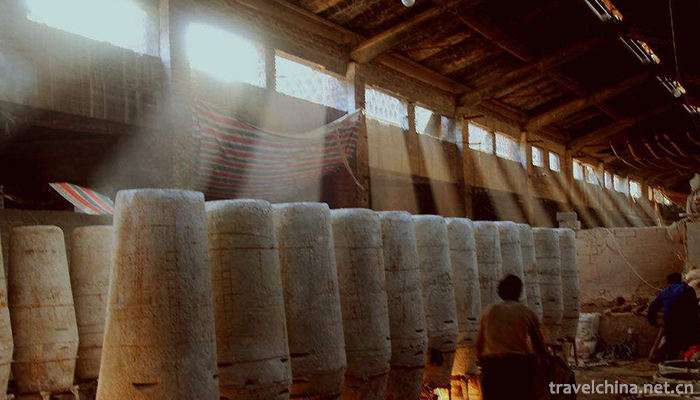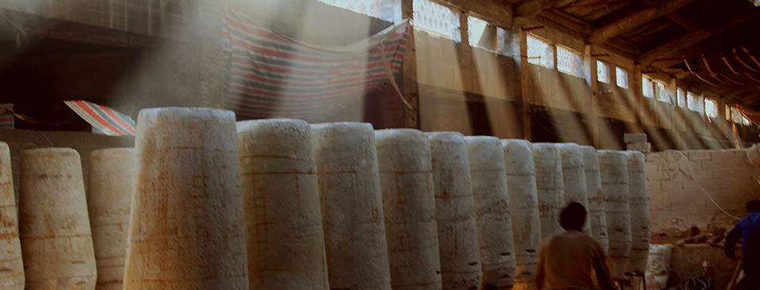Construction Techniques of Jingdezhen Traditional Porcelain Kiln Workshop
Construction Techniques of Jingdezhen Traditional Porcelain Kiln Workshop
Jingdezhen traditional porcelain kiln workshop building skills, Jiangxi Province Jingdezhen local traditional ceramic industry building and building skills, one of the national intangible cultural heritage.
Jingdezhen traditional ceramic kiln workshop construction technology is a kind of traditional ceramic kiln through the bricklaying, kiln repair, cha kiln, plastering and other steps to complete the traditional ceramic kiln.
On May 20, 2006, the craftsmanship of Jingdezhen traditional porcelain kiln workshop was listed in the first batch of national intangible cultural heritage list of traditional craftsmanship, item number_-29.
historical origin
According to Jingdezhen Taolu, there were two porcelain kilns in Jingdezhen in the Tang Dynasty, namely "pottery kiln" and "Huo kiln". The prevailing view is that the traditional porcelain kiln workshop in Jingdezhen should start in the Five Dynasties. "History of Chinese Ceramics" says, "Shengmeiting (formerly called Yangmei Pavilion), Shihuwan and Huangnitou in Jingdezhen, Jiangxi Province, are the earliest kiln sites for firing white porcelain in southern China.
In the Song and Yuan Dynasties, with the prosperity of Jingdezhen ceramics, the traditional porcelain kiln workshop in Jingdezhen also had a new development. According to The History of Jiangxi Ceramics, "Kilns are all around Jingdezhen... Shi (Bai) Huwan, Xianghu Street, Nanshi, Yingtan, Liujiawan, Sanbaobang, Ningcun, Niufeiling, Fengwan, Hutian and Dongjiawu,... It is not only the place where the kiln is located, but also the commercial transit place for the export of porcelain.
By the Ming and Qing Dynasties, the imperial kiln factory was set up in Zhushan, and Jingdezhen became the center of China's ceramic industry. The traditional kiln workshop in Jingdezhen also made a qualitative leap in its construction skills. At this time, the traditional kiln workshop in Jingdezhen's ceramic industry has entered a mature stage.
Process characteristics
The unique shape, structure, material and function requirements of kiln body, kiln house and billet house have contributed to the unique skill of kiln house construction. For example, since Yongzheng in Qing Dynasty, Jingdezhen is the most popular town kiln. Egg-shaped Town kiln belongs to flat flame kiln, which combines the advantages of Longyao kiln, steamed bread kiln and gourd kiln.
Masonry houses (i.e. workshops) are important production sites, with both residential functions and compact layout. The traditional kiln house in Jingdezhen has the triple functions of spacious ventilation, economy and practicality, warehouse, production workshop and living room. It puts forward high building standards for builders, requires superb craftsmanship and unique style, which creates the urban landscape of Jingdezhen, and achieves the building skills of Jingdezhen's ceramic industry buildings.
In Jingdezhen, kiln building (kiln building) and kiln mending (kiln repairing) are called "twin kilns". Its skill is very important in the porcelain industry. Owing to the unique skills of kiln building, kiln repairing, fir kiln and mud plastering, kiln owners often respect these stores and technicians very much and dare not neglect them. The craftsmanship of the twin kiln is the most profitable link in the production of the porcelain industry. Each kiln can get 40 silver yuan. Even if some kilns don't have twin kilns in a year, they have to give two loads of rice to the twin kiln shop every time they are fired, as the living expenses of the master of the twin kiln. According to legend, a kiln worker can earn 100 tons of rice a year. The workers in the twin kilns are busy from the first month of the lunar calendar to March every year, but they are leisurely in the rest of the year. So Jingdezhen has a folk proverb, "Life is good, Yu Fang-lao (referring to the master surnamed Yu of the twin kiln)". It usually takes five days to build or repair a kiln. The cramped kiln master is responsible for several major technical tasks, such as laying kiln foundations, kiln knots and sealing kiln awnings. The kiln chimney and the rest of the work are completed by the towers, watchmakers and four apprentices of the kiln household. Since the late Qing Dynasty, the master of Jingdezhen Longyao kiln was a member of the Yu family in Yufang Village, Huamen Lou, Duchang County. Their cramped kiln skills are taught only by their nephews and sons. Only when their apprentices are especially short of manpower can they return to Duchang and select a small number of ethnic groups to learn art.
Inheritance and protection
Inheritance value
As an important part of Chinese traditional porcelain culture, Jingdezhen's traditional ceramic industry construction technology is the cultural wealth handed down from generation to generation by the Chinese nation. Jingdezhen's traditional ceramic workshop and kiln house construction techniques bear extensive and profound ceramic culture of the motherland and the earliest germination of national capitalism. They compose the most brilliant chapter of ancient Chinese handicraft civilization. They are also rare site material evidence of ancient Chinese workshops'handicraft industry. They have unique and rich historical, scientific, folklore and tourist landscape values. Its main contents are kiln house building skills and billet house building skills.
Jingdezhen's traditional ceramic workshops, kilns and construction techniques are directly and substantially related to the world-renowned Jingdezhen porcelain. Ancient beautiful artistic porcelain comes from these historical relics immersed in unique skills. Despite the vicissitudes of life, Jingdezhen has retained a large number of large-scale and fairly complete and complex relics of the porcelain industry system of past dynasties, which are still continuing and infiltrating Jingdezhen culture. The traditional architecture and techniques of Jingdezhen porcelain industry are one of the most valuable parts. For Jingdezhen, this intangible cultural heritage is one of the basic identification signs of Jingdezhen as a world brand, and one of the important foundations for the existence and development of Jingdezhen folk culture. Protecting this unique and important cultural heritage, studying and developing its traditional essence will provide a powerful inspiration for building a more attractive future civilization.
Inheriting characters
Yuyunshan, male, was born in May 1942. On May 26, 2009, Yuyunshan was selected as the representative successor of the third batch of national intangible cultural heritage projects and declared by Jiangxi Province. Project Name: Jingdezhen Traditional Porcelain Kiln Workshop Construction Techniques.
Hu Jiawang, male. In May 2018, Hu Jiawang was selected as the representative successor of the fifth batch of national intangible cultural heritage projects and declared by Jiangxi Province. Project Name: Jingdezhen Traditional Porcelain Kiln Workshop Construction Techniques.
protective measures
In July 2016, Jizhou Kiln Scenic Area in Ji'an City, Jiangxi Province, needs to build a steamed bread kiln. Yu Zuxing, a son and apprentice of Yuyunshan and a representative inheritor at the provincial level, went to build the kiln alone. At this time, the inheritor was sick in bed. Therefore, considering various factors, the inheritor's son Yu Zuxing took the place of the production of the inheritance teaching film. While building the kiln, he explained and demonstrated the skills of the inheritor's professor. Art.
social influence
Important activities
On June 14, 2014, "China Cultural Heritage Day 2014" was held in Jingdezhen City, Jiangxi Province. It represents the first time that Jingdezhen ancient kiln has been rejuvenated and opened, which represents the construction skills of Jingdezhen traditional porcelain kiln workshop.


-
1.Kaifeng soup dumplings
Kaifeng filling soup bag is one of the famous foods in Kaifeng because of its unique flavor. The soup is thin and white like Jingdezhen ceramics. It has a transparent feeling
Time 2018-11-26 -
2.Chibi ancient battlefield
The ancient battlefield of Chibi in the Three Kingdoms, where the battle of Chibi took place, is located on the South Bank of the Yangtze River in the northwest of Chibi City, Hubei Province
Time 2018-12-12 -
3.Bian Que Temple Tourist Area
Bian Que Temple, also known as Bian Que Temple, is situated at the foot of Que Mountain, 26 kilometers west of Neiqiu County Town. It is an ancient building group to worship and worship the Chinese me
Time 2019-01-03 -
4.Laiwu Campaign Memorial
Laiwu Campaign Memorial Hall is situated on the Huangshan Mountain in Laiwu District, Jinan City. It covers an area of 45,000 square meters and has a building area of more than 8,000 square meters
Time 2019-01-29 -
5.Xinyingtai Eco Spa Resort
Yingtai Eco-Hot Spring Resort (Eco-Park) is located on the parallel road of Tengzhou City, Shandong Province. It is a comprehensive service enterprise integrating eco-catering
Time 2019-02-26 -
6.The Old Site of Zaoyuan Revolution
Zaoyuan is located 8 kilometers northwest of Yan'an City. It is a garden-like revolutionary memorial. There are many kinds of flowers, plants and trees growing in it. The scenery is beautiful and the
Time 2019-03-09 -
7.Panwang Song
Panwang Song is a collection of Yao folk poetry. Mainly spread in the residential areas of the Yao nationality in Nanling Mountains, Jianghua is a folk literature with distinct national characteristic
Time 2019-06-08 -
8.Legend of Yao
The legend of Yao is one of the local folklores in Jiangxian County, Shanxi Province. Yao is the Saint King of ancient Chinese legend. It is said that later generations named him Tao Tang and surnamed
Time 2019-07-11 -
9.North Sichuan Medical College
North Sichuan Medical College is located in Nanchong City, a famous historical and cultural city in Sichuan Province and the birthplace of Three Kingdoms Culture. The school's predecessor was the Nort
Time 2019-08-31 -
10.Longtan Karst Cave Scenic Spot
Longtan Karst Cave Scenic Area is located at the foot of longcuban mountain, Miyi Baima Town, Panzhihua City, Sichuan Province, with an altitude of 1500 meters. It is a provincial-level scenic spot and a national AA level tourist area.
Time 2020-10-15 -
11.Lingshan Temple
Lingshan temple is located in Mianning County, Liangshan Prefecture, Sichuan Province. It is 8 km away from Mianning County. It is the most famous temple in Liangshan Prefecture. It belongs to Mianning County as well as Xichang Satellite Launch Center.
Time 2020-10-16 -
12.Xiaoxiangling scenic spot
The synonym Xiaoxiangling generally refers to Xiaoxiangling scenic spot
Time 2020-10-16